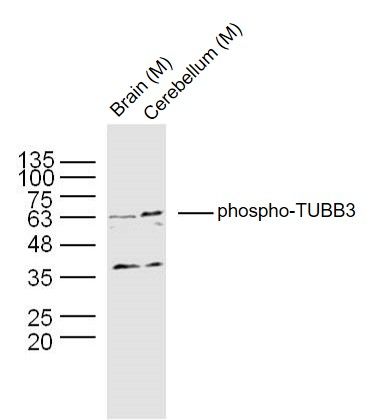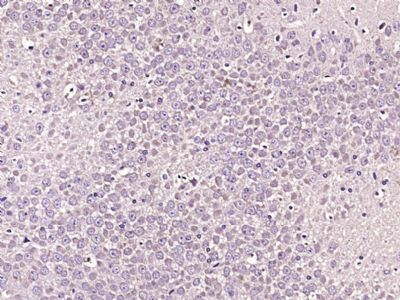产品中心
当前位置:首页>产品中心Anti-phospho-TUBB3 (Ser172)
货号: bs-20288R 基本售价: 1580.0 元 规格: 100ul
产品信息
- 产品编号
- bs-20288R
- 英文名称
- phospho-TUBB3 (Ser172)
- 中文名称
- 磷酸化神经细胞特异性微管蛋白抗体
- 别 名
- beta III Tubulin (phospho S172); p-beta III Tubulin (phospho S172); TUBB3(phospho S172); beta 4; MC1R; TBB3_HUMAN; TUBB 3; TUBB 4; TUBB3; TUBB4; Tubulin beta 3 chain; Tubulin beta 4; Tubulin beta III; Tubulin beta-3 chain; Tubulin beta-4 chain; Tubulin beta-III. TUJ1
- 规格价格
- 100ul/1580元购买 大包装/询价
- 说 明 书
- 100ul
- 产品类型
- 磷酸化抗体
- 研究领域
- 细胞生物 免疫学 神经生物学 信号转导 细胞骨架
- 抗体来源
- Rabbit
- 克隆类型
- Polyclonal
- 交叉反应
- Human, Mouse, Rat, Rabbit,
- 产品应用
- WB=1:500-2000 ELISA=1:500-1000 IHC-P=1:400-800 IHC-F=1:400-800 ICC=1:100-500 IF=1:100-500 (石蜡切片需做抗原修复)
not yet tested in other applications.
optimal dilutions/concentrations should be determined by the end user.
- 分 子 量
- 50-55kDa
- 细胞定位
- 细胞浆
- 性 状
- Lyophilized or Liquid
- 浓 度
- 1mg/ml
- 免 疫 原
- KLH conjugated Synthesised phosphopeptide derived from human TUBB3 around the phosphorylation site of Ser172:VP(p-S)PK
- 亚 型
- IgG
- 纯化方法
- affinity purified by Protein A
- 储 存 液
- Preservative: 15mM Sodium Azide, Constituents: 1% BSA, 0.01M PBS, pH 7.4
- 保存条件
- Store at -20 °C for one year. Avoid repeated freeze/thaw cycles. The lyophilized antibody is stable at room temperature for at least one month and for greater than a year when kept at -20°C. When reconstituted in sterile pH 7.4 0.01M PBS or diluent of antibody the antibody is stable for at least two weeks at 2-4 °C.
- PubMed
- PubMed
- 产品介绍
- background:
Tubulin is a major cytoskeleton component that has five distinct forms, designated a, b, g, d and e tubulin. a and b tubulins form heterodimers which multimerize to form a microtubule filament. Multiple b Tubulin isoforms (b1, b2, b3, b4, b5, b6 and b8) have been characterized and are expressed in mammalian tissues. b1 and b4 are present throughout the cytosol, b2 is present in the nuclei and nucleoplasm, and b3 is a neuron-specific cytoskeletal protein. g Tubulin forms the gammasome, which is required for nucleating microtubule filaments at the centrosome. Both d Tubulin and e Tubulin are associated with the centrosome. d Tubulin is a homolog of the Chlamydomonas d Tubulin Uni3 and is found in association with the centrioles, whereas e Tubulin localizes to the pericentriolar material. e Tubulin exhibits a cell cycle-specific pattern of localization; first associating with only the older of the centrosomes in a newly duplicated pair, and later associating with both centrosomes.
Function:
Tubulin is the major constituent of microtubules. It binds two moles of GTP, one at an exchangeable site on the beta chain and one at a non-exchangeable site on the alpha-chain. TUBB3 plays a critical role in proper axon guidance and mantainance.
Subunit:
Dimer of alpha and beta chains.
Subcellular Location:
Cytoplasm; cytoskeleton.
Tissue Specificity:
Expression is primarily restricted to central and peripheral nervous system.
Post-translational modifications:
Some glutamate residues at the C-terminus are polyglutamylated. This modification occurs exclusively on glutamate residues and results in polyglutamate chains on the gamma-carboxyl group. Also monoglycylated but not polyglycylated due to the absence of functional TTLL10 in human. Monoglycylation is mainly limited to tubulin incorporated into axonemes (cilia and flagella) whereas glutamylation is prevalent in neuronal cells, centrioles, axonemes, and the mitotic spindle. Both modifications can coexist on the same protein on adjacent residues, and lowering glycylation levels increases polyglutamylation, and reciprocally. The precise function of such modifications is still unclear but they regulate the assembly and dynamics of axonemal microtubules.
DISEASE:
Defects in TUBB3 are the cause of congenital fibrosis of extraocular muscles type 3A (CFEOM3A) [MIM:600638]. A congenital ocular motility disorder marked by restrictive ophthalmoplegia affecting extraocular muscles innervated by the oculomotor and/or trochlear nerves. It is clinically characterized by anchoring of the eyes in downward gaze, ptosis, and backward tilt of the head. Congenital fibrosis of extraocular muscles type 3 presents as a non-progressive, autosomal dominant disorder with variable expression. Patients may be bilaterally or unilaterally affected, and their oculo-motility defects range from complete ophthalmoplegia (with the eyes fixed in a hypo- and exotropic position), to mild asymptomatic restrictions of ocular movement. Ptosis, refractive error, amblyopia, and compensatory head positions are associated with the more severe forms of the disorder. In some cases the ocular phenotype is accompanied by additional features including developmental delay, corpus callosum agenesis, basal ganglia dysmorphism, facial weakness, polyneuropathy.
Similarity:
Belongs to the tubulin family.
SWISS:
Q13509
Gene ID:
10381
Database links:Entrez Gene: 10381 Human
Entrez Gene: 22152 Mouse
Entrez Gene: 246118 Rat
Omim: 602661 Human
SwissProt: Q13509 Human
SwissProt: Q9ERD7 Mouse
SwissProt: Q4QRB4 Rat
Unigene: 511743 Human
Unigene: 40068 Mouse
Unigene: 43958 Rat
Important Note:
This product as supplied is intended for research use only, not for use in human, therapeutic or diagnostic applications.
- 产品图片
 Sample:
Sample:
Brain (Mouse) Lysate at 40 ug
Cerebellum (Mouse) Lysate at 40 ug
Primary: Anti- p-TUBB3 (Ser172) (bs-20288R)at 1/300 dilution
Secondary: IRDye800CW Goat Anti-Rabbit IgG at 1/20000 dilution
Predicted band size: 50/55 kD
Observed band size: 63 kD Paraformaldehyde-fixed, paraffin embedded (Rat brain); Antigen retrieval by microwave in sodium citrate buffer (pH6.0) ; Block endogenous peroxidase by 3% hydrogen peroxide for 30 minutes; Blocking buffer (3% BSA) at RT for 30min; Antibody incubation with (phospho-TUBB3 (Ser172)) Polyclonal Antibody, Unconjugated (bs-20288R) at 1:400 overnight at 4℃, followed by conjugation to the secondary antibody (labeled with HRP)and DAB staining.
Paraformaldehyde-fixed, paraffin embedded (Rat brain); Antigen retrieval by microwave in sodium citrate buffer (pH6.0) ; Block endogenous peroxidase by 3% hydrogen peroxide for 30 minutes; Blocking buffer (3% BSA) at RT for 30min; Antibody incubation with (phospho-TUBB3 (Ser172)) Polyclonal Antibody, Unconjugated (bs-20288R) at 1:400 overnight at 4℃, followed by conjugation to the secondary antibody (labeled with HRP)and DAB staining.

